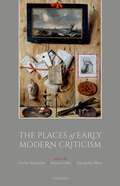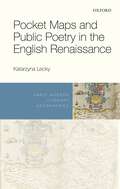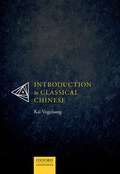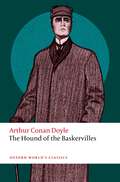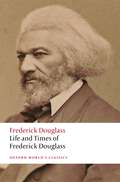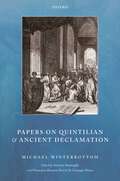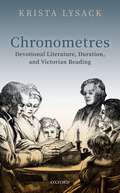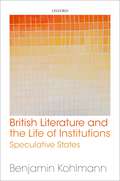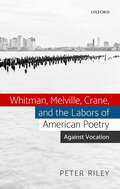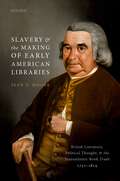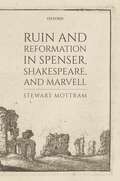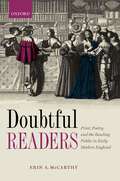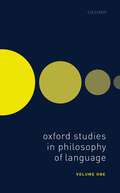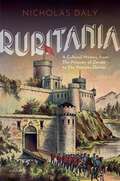- Table View
- List View
The Places of Early Modern Criticism
by Gavin Alexander Emma Gilby Alexander MarrWhat is criticism? And where is it to be found? Thinking about literature and the visual arts is found in many places - in treatises, apologies, and paragoni; in prefaces, letters, and essays; in commentaries, editions, reading notes, and commonplace books; in images, sculptures, and built spaces; within or on the thresholds of works of poetry and visual art. It is situated between different disciplines and methods. Critical ideas and methods come into England from other countries, and take root in particular locations - the court, the Inns of Court, the theatre, the great house, the printer's shop, the university. The practice of criticism is transplanted to the Americas and attempts to articulate the place of poetry in a new world. And commonplaces of classical poetics and rhetoric serve both to connect and to measure the space between different critical discourses. Tracing the history of the development of early modern thinking about literature and the visual arts requires consideration of various kinds of place - material, textual, geographical - and the practices particular to those places; it also requires that those different places be brought into dialogue with each other. This book brings together scholars working in departments of English, modern languages, and art history to look at the many different places of early modern criticism. It argues polemically for the necessity of looking afresh at the scope of criticism, and at what happens on its margins; and for interrogating our own critical practices and disciplinary methods by investigating their history.
Pocket Maps and Public Poetry in the English Renaissance (Early Modern Literary Geographies)
by Katarzyna LeckyKatarzyna Lecky explores how early modern British poets paid by the state adapted inclusive modes of nationhood charted by inexpensive, small-format maps. She explores chapbooks ('cheapbooks') by Edmund Spenser, Samuel Daniel, Ben Jonson, William Davenant, and John Milton alongside the portable cartography circulating in the same retail print industry. Domestic pocket maps were designed for heavy use by a broad readership that included those on the fringes of literacy. The era's de facto laureates all banked their success as writers appealing to this burgeoning market share by drawing the nation as the property of the commonwealth rather than the Crown. This book investigates the accessible world of small-format cartography as it emerges in the texts of the poets raised in the expansive public sphere in which pocket maps flourished. It works at the intersections of space, place, and national identity to reveal the geographical imaginary shaping the flourishing business of cheap print. Its placement of poetic economies within mainstream systems of trade also demonstrates how cartography and poetry worked together to mobilize average consumers as political agents. This everyday form of geographic poiesis was also a strong platform for poets writing for monarchs and magistrates when their visions of the nation ran counter to the interests of the government.
Pocket Maps and Public Poetry in the English Renaissance (Early Modern Literary Geographies)
by Katarzyna LeckyKatarzyna Lecky explores how early modern British poets paid by the state adapted inclusive modes of nationhood charted by inexpensive, small-format maps. She explores chapbooks ('cheapbooks') by Edmund Spenser, Samuel Daniel, Ben Jonson, William Davenant, and John Milton alongside the portable cartography circulating in the same retail print industry. Domestic pocket maps were designed for heavy use by a broad readership that included those on the fringes of literacy. The era's de facto laureates all banked their success as writers appealing to this burgeoning market share by drawing the nation as the property of the commonwealth rather than the Crown. This book investigates the accessible world of small-format cartography as it emerges in the texts of the poets raised in the expansive public sphere in which pocket maps flourished. It works at the intersections of space, place, and national identity to reveal the geographical imaginary shaping the flourishing business of cheap print. Its placement of poetic economies within mainstream systems of trade also demonstrates how cartography and poetry worked together to mobilize average consumers as political agents. This everyday form of geographic poiesis was also a strong platform for poets writing for monarchs and magistrates when their visions of the nation ran counter to the interests of the government.
Introduction to Classical Chinese
by Kai VogelsangThis textbook provides a comprehensive scholarly introduction to Classical Chinese and its texts. Classical Chinese is the language of Confucius and Mencius and their contemporaries, who wrote the seminal texts of Chinese philosophy more than 2,000 years ago. Although it was used as a living language for only a relatively short time, it was the foundation of Chinese education throughout the Imperial age, and formed the basis of a literary tradition that continues to the present day. This book offers students all the necessary tools to read, understand, and analyse Classical Chinese texts, including: step-by-step clearly illustrated descriptions of syntactic features; core vocabulary lists; introductions to relevant historical and cultural topics; selected readings from classical literature with original commentaries and in-depth explanations; introductions to dictionaries and other reference works on the study of ancient China; and a guide to philological methods used in the critical analysis of Classical Chinese texts. The extensive glossary provides phonological reconstructions, word classes, English translations, and citations to illustrate usage, while the up-to-date bibliography serves as a valuable starting point for further research.
The Hound of the Baskervilles (Oxford World's Classics)
by Darryl Jones'Mr Holmes, they were the footprints of a gigantic hound!' The mysterious death of Sir Charles Baskerville brings Sherlock Holmes and Dr Watson to Dartmoor in the most famous of all of Arthur Conan Doyle's books. Is Sir Charles the latest victim of the ancestral Curse of the Baskervilles, which summons a demonic hound to stalk the moor and exact vengeance for a past misdeed, or is there a more modern, more prosaic explanation for the sudden death? In The Hound of the Baskervilles, the modern, rational world, and the ancient, supernatural world collide in the novel which brought Sherlock Holmes back from the dead. This new edition of Conan Doyle's classic mystery is part of a series of new editions of the Sherlock Holmes stories published in Oxford World's Classics. Darryl Jones's Introduction explores the competing worlds of the supernatural and the scientific in the novel and in Arthur Conan Doyle's life, the novel's colonial background and origins, and the role of landscape, folklore, and folk horror in the novel.
The Hound of the Baskervilles (Oxford World's Classics)
by Darryl Jones'Mr Holmes, they were the footprints of a gigantic hound!' The mysterious death of Sir Charles Baskerville brings Sherlock Holmes and Dr Watson to Dartmoor in the most famous of all of Arthur Conan Doyle's books. Is Sir Charles the latest victim of the ancestral Curse of the Baskervilles, which summons a demonic hound to stalk the moor and exact vengeance for a past misdeed, or is there a more modern, more prosaic explanation for the sudden death? In The Hound of the Baskervilles, the modern, rational world, and the ancient, supernatural world collide in the novel which brought Sherlock Holmes back from the dead. This new edition of Conan Doyle's classic mystery is part of a series of new editions of the Sherlock Holmes stories published in Oxford World's Classics. Darryl Jones's Introduction explores the competing worlds of the supernatural and the scientific in the novel and in Arthur Conan Doyle's life, the novel's colonial background and origins, and the role of landscape, folklore, and folk horror in the novel.
Life and Times of Frederick Douglass: Written by Himself (Oxford World's Classics)
by Frederick Douglass'It will be seen in these pages that I have lived several lives in one: first, the life of slavery; secondly, the life of a fugitive from slavery; thirdly, the life of comparative freedom; fourthly, the life of conflict and battle; and, fifthly, the life of victory, if not complete, at least assured.' First published in 1892, Life and Times of Frederick Douglass Written By Himself is the final autobiography written by Frederick Douglass (1818-1895), a man who was born into slavery in Talbot County, Maryland. Securing his self-liberation at twenty years of age in 1838, he went on to become the most renowned antislavery activist, social justice campaigner, author, orator, philosopher, essayist, historian, intellectual, statesman, and liberator in U.S. history. A powerful literary work, Douglass' final autobiography shares the stories of his 'several lives in one.' Beginning with his war against 'the hell-black system of human bondage,' Douglass bears witness to his personal experiences of mind-body-and soul-destroying tragedies. Living a new life as a 'fugitive from slavery,' he tells his audiences of his decades-long labours as a world-leading freedom-fighter. Ever vigilant in his protest against the discriminatory persecutions endured by millions of 'my people,' he testifies to the terrible reality that his 'life of comparative freedom' necessitated a lifelong fight against the inhumane injustices of 'American prejudice against colour.' Living a death-defying 'life of conflict and battle' during the Civil War, Douglass celebrates the 'life of victory' promised by post-war civil rights legislation only to condemn the failures of the U.S. nation either to exterminate slavery or secure equal rights for all. All too painfully aware that the 'conflict between the spirit of liberty and the spirit of slavery' was far from over and would become the unending struggle for 'aftercoming generations' in the ongoing war against white supremacy, Douglass remained a fearless fighter against the 'infernal and barbarous spirit of slavery' 'wherever I find it' to the day that he died. This new edition examines Douglass' memorialization of his own and his mother Harriet Bailey's first-hand experiences of enslavement and of their 'mental' liberation through a 'love of letters'; his representation of Civil War Black combat heroism; his conviction that 'education means emancipation'; and finally, his 'unending battle' with white publishers for the freedom to 'tell my story.' This volume reproduces Frederick Douglass' emotionally powerful and politically hard-hitting anti-lynching speech, Lessons of the Hour, published in 1894. ABOUT THE SERIES: For over 100 years Oxford World's Classics has made available the widest range of literature from around the globe. Each affordable volume reflects Oxford's commitment to scholarship, providing the most accurate text plus a wealth of other valuable features, including expert introductions by leading authorities, helpful notes to clarify the text, up-to-date bibliographies for further study, and much more.
Life and Times of Frederick Douglass: Written by Himself (Oxford World's Classics)
by Frederick Douglass'It will be seen in these pages that I have lived several lives in one: first, the life of slavery; secondly, the life of a fugitive from slavery; thirdly, the life of comparative freedom; fourthly, the life of conflict and battle; and, fifthly, the life of victory, if not complete, at least assured.' First published in 1892, Life and Times of Frederick Douglass Written By Himself is the final autobiography written by Frederick Douglass (1818-1895), a man who was born into slavery in Talbot County, Maryland. Securing his self-liberation at twenty years of age in 1838, he went on to become the most renowned antislavery activist, social justice campaigner, author, orator, philosopher, essayist, historian, intellectual, statesman, and liberator in U.S. history. A powerful literary work, Douglass' final autobiography shares the stories of his 'several lives in one.' Beginning with his war against 'the hell-black system of human bondage,' Douglass bears witness to his personal experiences of mind-body-and soul-destroying tragedies. Living a new life as a 'fugitive from slavery,' he tells his audiences of his decades-long labours as a world-leading freedom-fighter. Ever vigilant in his protest against the discriminatory persecutions endured by millions of 'my people,' he testifies to the terrible reality that his 'life of comparative freedom' necessitated a lifelong fight against the inhumane injustices of 'American prejudice against colour.' Living a death-defying 'life of conflict and battle' during the Civil War, Douglass celebrates the 'life of victory' promised by post-war civil rights legislation only to condemn the failures of the U.S. nation either to exterminate slavery or secure equal rights for all. All too painfully aware that the 'conflict between the spirit of liberty and the spirit of slavery' was far from over and would become the unending struggle for 'aftercoming generations' in the ongoing war against white supremacy, Douglass remained a fearless fighter against the 'infernal and barbarous spirit of slavery' 'wherever I find it' to the day that he died. This new edition examines Douglass' memorialization of his own and his mother Harriet Bailey's first-hand experiences of enslavement and of their 'mental' liberation through a 'love of letters'; his representation of Civil War Black combat heroism; his conviction that 'education means emancipation'; and finally, his 'unending battle' with white publishers for the freedom to 'tell my story.' This volume reproduces Frederick Douglass' emotionally powerful and politically hard-hitting anti-lynching speech, Lessons of the Hour, published in 1894. ABOUT THE SERIES: For over 100 years Oxford World's Classics has made available the widest range of literature from around the globe. Each affordable volume reflects Oxford's commitment to scholarship, providing the most accurate text plus a wealth of other valuable features, including expert introductions by leading authorities, helpful notes to clarify the text, up-to-date bibliographies for further study, and much more.
Papers on Quintilian and Ancient Declamation
by Michael WinterbottomDeclamation - the practice of training young men to speak in public by setting them to compose and deliver speeches on fictional legal cases - was central to the Greek and Roman educational systems over many centuries and has been the subject of a recent explosion of scholarly interest. The work of Michael Winterbottom has been seminal in this regard, and the present volume brings together a broad selection of his scholarly articles and reviews published since 1964, creating an authoritative and accessible resource for this burgeoning field of study. The assembled papers focus on two related topics: the rhetorician Quintilian and ancient declamation in practice. Quintilian, who taught rhetoric at Rome in the second half of the first century AD, was the author of the Institutio Oratoria, a key text for Roman educational practice, rhetoric, and literary criticism. Subjects explored in the present collection range widely over not only the establishment and interpretation of the text and its literary and historical context, but also Quintilian's views on inspiration, morality, philosophy, and declamation, of which he was a practitioner. While the volume also offers detailed examinations of the texts and interpretations of a wide range of Latin and Greek authors of declamations, such as Seneca the Elder, Sopatros, and Ennodius, there is a particular focus on two collections wrongly attributed to Quintilian, the so-called 'Minor' and 'Major Declamations'. A major re-assessment of the manuscript tradition of the latter collection is published here for the first time.
Papers on Quintilian and Ancient Declamation
by Michael WinterbottomDeclamation - the practice of training young men to speak in public by setting them to compose and deliver speeches on fictional legal cases - was central to the Greek and Roman educational systems over many centuries and has been the subject of a recent explosion of scholarly interest. The work of Michael Winterbottom has been seminal in this regard, and the present volume brings together a broad selection of his scholarly articles and reviews published since 1964, creating an authoritative and accessible resource for this burgeoning field of study. The assembled papers focus on two related topics: the rhetorician Quintilian and ancient declamation in practice. Quintilian, who taught rhetoric at Rome in the second half of the first century AD, was the author of the Institutio Oratoria, a key text for Roman educational practice, rhetoric, and literary criticism. Subjects explored in the present collection range widely over not only the establishment and interpretation of the text and its literary and historical context, but also Quintilian's views on inspiration, morality, philosophy, and declamation, of which he was a practitioner. While the volume also offers detailed examinations of the texts and interpretations of a wide range of Latin and Greek authors of declamations, such as Seneca the Elder, Sopatros, and Ennodius, there is a particular focus on two collections wrongly attributed to Quintilian, the so-called 'Minor' and 'Major Declamations'. A major re-assessment of the manuscript tradition of the latter collection is published here for the first time.
Chronometres: Devotional Literature, Duration, and Victorian Reading
by Krista LysackWhat does it mean to feel time, to sense its passing along the sinews and nerves of the body as much as the synapses of the mind? And how do books, as material arrangements of print and paper, mediate such temporal experiences? Chronometres: Devotional Literature, Duration, and Victorian Reading Culture is a study of the time-inflected reading practices of religious literature, the single largest market for print in Victorian Britain. It examines poetic cycles by John Keble, Alfred Tennyson, Christina Rossetti, and Frances Ridley Havergal; family prayer manuals, Sunday-reading books and periodicals; and devotional gift books and daily textbooks. Designed for diurnal and weekly reading, chronometrical literature tuned its readers' attentions to the idea of eternity and the everlasting peace of spiritual transcendence, but only in so far as it parcelled out reading into discrete increments that resembled the new industrial time-scales of factories and railway schedules. Chronometres thus takes up print culture, affect theory, and the religious turn in literary studies in order to explore the intersections between devotional practice and the condition of modernity. It argues that what defines Victorian devotional literature is the experience of its time signatures, those structures of feeling associated with its reading durations. For many Victorians, reading devotionally increasingly meant reading in regular portions and often according to the calendar and work-day in contrast to the liturgical year. Keeping pace with the temporal measures of modernity, devotion became a routinized practice: a way of synchronizing the interior life of spirit with the exigencies of clock time. Chronometres considers how the deliverances afforded through time-scaled reading are persistently materialised in the body, both that of the book and of the reader. Recognizing that literature and devotion are not timeless abstractions, it asks how the materiality of books, conceived as horological relationships through reading, might bring about the felt experience of time. Even as Victorian devotion invites us to tarry over the page, it also prompts the question: what if it is 'eternity' that keeps time with the clock?
Chronometres: Devotional Literature, Duration, and Victorian Reading
by Krista LysackWhat does it mean to feel time, to sense its passing along the sinews and nerves of the body as much as the synapses of the mind? And how do books, as material arrangements of print and paper, mediate such temporal experiences? Chronometres: Devotional Literature, Duration, and Victorian Reading Culture is a study of the time-inflected reading practices of religious literature, the single largest market for print in Victorian Britain. It examines poetic cycles by John Keble, Alfred Tennyson, Christina Rossetti, and Frances Ridley Havergal; family prayer manuals, Sunday-reading books and periodicals; and devotional gift books and daily textbooks. Designed for diurnal and weekly reading, chronometrical literature tuned its readers' attentions to the idea of eternity and the everlasting peace of spiritual transcendence, but only in so far as it parcelled out reading into discrete increments that resembled the new industrial time-scales of factories and railway schedules. Chronometres thus takes up print culture, affect theory, and the religious turn in literary studies in order to explore the intersections between devotional practice and the condition of modernity. It argues that what defines Victorian devotional literature is the experience of its time signatures, those structures of feeling associated with its reading durations. For many Victorians, reading devotionally increasingly meant reading in regular portions and often according to the calendar and work-day in contrast to the liturgical year. Keeping pace with the temporal measures of modernity, devotion became a routinized practice: a way of synchronizing the interior life of spirit with the exigencies of clock time. Chronometres considers how the deliverances afforded through time-scaled reading are persistently materialised in the body, both that of the book and of the reader. Recognizing that literature and devotion are not timeless abstractions, it asks how the materiality of books, conceived as horological relationships through reading, might bring about the felt experience of time. Even as Victorian devotion invites us to tarry over the page, it also prompts the question: what if it is 'eternity' that keeps time with the clock?
British Literature and the Life of Institutions: Speculative States
by Benjamin KohlmannBritish Literature and the Life of Institutions charts a literary prehistory of the welfare state in Britain around 1900, but it also marks a major intervention in current theoretical debates about critique and the dialectical imagination. By placing literary studies in dialogue with political theory, philosophy, and the history of ideas, the book reclaims a substantive reformist language that we have ignored to our own loss. This reformist idiom made it possible to imagine the state as a speculative and aspirational idea—as a fully realized form of life rather than as an uninspiring ensemble of administrative procedures and bureaucratic processes. This volume traces the resonances of this idiom from the Victorian period to modernism, ranging from Mary Augusta Ward, George Gissing, and H. G. Wells, to Edward Carpenter, E. M. Forster, and Virginia Woolf. Compared to this reformist language, the economism that dominates current debates about the welfare state signals an impoverishment that is at once intellectual, cultural, and political. Critiquing the shortcomings of the welfare state comes naturally to us, but we often struggle to offer up convincing defences of its principles and aims. This book intervenes in these debates by urging a richer understanding of critique: if we want to defend the state, Kohlmann argues, we need to learn to think about it again.
British Literature and the Life of Institutions: Speculative States
by Benjamin KohlmannBritish Literature and the Life of Institutions charts a literary prehistory of the welfare state in Britain around 1900, but it also marks a major intervention in current theoretical debates about critique and the dialectical imagination. By placing literary studies in dialogue with political theory, philosophy, and the history of ideas, the book reclaims a substantive reformist language that we have ignored to our own loss. This reformist idiom made it possible to imagine the state as a speculative and aspirational idea—as a fully realized form of life rather than as an uninspiring ensemble of administrative procedures and bureaucratic processes. This volume traces the resonances of this idiom from the Victorian period to modernism, ranging from Mary Augusta Ward, George Gissing, and H. G. Wells, to Edward Carpenter, E. M. Forster, and Virginia Woolf. Compared to this reformist language, the economism that dominates current debates about the welfare state signals an impoverishment that is at once intellectual, cultural, and political. Critiquing the shortcomings of the welfare state comes naturally to us, but we often struggle to offer up convincing defences of its principles and aims. This book intervenes in these debates by urging a richer understanding of critique: if we want to defend the state, Kohlmann argues, we need to learn to think about it again.
Whitman, Melville, Crane, and the Labors of American Poetry: Against Vocation
by Peter RileyIn Whitman, Melville, Crane, and the Labors of American Poetry, Peter Riley confronts our enduring and problematic investment in poetic vocation—a myth, he argues, that continues to inform how all our multifarious labors are understood, valued, and exploited. The book seeks to challenge a dominant cultural logic that frames contingent, non-vocational labor as a necessary sacrifice that frustrates the righteous progress towards realizing that seemingly purest of callings: Poet. Incorporating the often overlooked or excluded workaday ephemera of three canonical US Romantic poets—Walt Whitman, Herman Melville, and Hart Crane—this volume offers new archival insights that call for a re-examination of celebrated literary careers and disputes their status as renowned or tragic icons of creative vocation. The poetry of Whitman the real estate dealer, Melville the customs inspector, and Crane the copywriter, Riley contends, does not constitute the formal inscription of an antagonistic or discreet poetic labor struggling against quotidian work towards the fulfilment of exceptional individual callings. Instead, the distracted forms of their poetry are always already intermingled with a variety of apparently lesser labors. Ousting poetic production from its default sanctuary of privileged exemption or transcendent repose, the volume refigures the work of the poet as a living sensuous activity that transgresses labor's various divisions and hierarchies. It consequently recasts the poet as a figure who actually unfastens the 'right of passage' vocational logic that does so much to secure and reproduce the current neoliberal paradigm.
Whitman, Melville, Crane, and the Labors of American Poetry: Against Vocation
by Peter RileyIn Whitman, Melville, Crane, and the Labors of American Poetry, Peter Riley confronts our enduring and problematic investment in poetic vocation—a myth, he argues, that continues to inform how all our multifarious labors are understood, valued, and exploited. The book seeks to challenge a dominant cultural logic that frames contingent, non-vocational labor as a necessary sacrifice that frustrates the righteous progress towards realizing that seemingly purest of callings: Poet. Incorporating the often overlooked or excluded workaday ephemera of three canonical US Romantic poets—Walt Whitman, Herman Melville, and Hart Crane—this volume offers new archival insights that call for a re-examination of celebrated literary careers and disputes their status as renowned or tragic icons of creative vocation. The poetry of Whitman the real estate dealer, Melville the customs inspector, and Crane the copywriter, Riley contends, does not constitute the formal inscription of an antagonistic or discreet poetic labor struggling against quotidian work towards the fulfilment of exceptional individual callings. Instead, the distracted forms of their poetry are always already intermingled with a variety of apparently lesser labors. Ousting poetic production from its default sanctuary of privileged exemption or transcendent repose, the volume refigures the work of the poet as a living sensuous activity that transgresses labor's various divisions and hierarchies. It consequently recasts the poet as a figure who actually unfastens the 'right of passage' vocational logic that does so much to secure and reproduce the current neoliberal paradigm.
Slavery and the Making of Early American Libraries: British Literature, Political Thought, and the Transatlantic Book Trade, 1731-1814
by Sean D. MooreEarly American libraries stood at the nexus of two transatlantic branches of commerce—the book trade and the slave trade. Slavery and the Making of Early American Libraries bridges the study of these trades by demonstrating how Americans' profits from slavery were reinvested in imported British books and providing evidence that the colonial book market was shaped, in part, by the demand of slave owners for metropolitan cultural capital. Drawing on recent scholarship that shows how participation in London cultural life was very expensive in the eighteenth century, as well as evidence that enslavers were therefore some of the few early Americans who could afford to import British cultural products, the volume merges the fields of the history of the book, Atlantic studies, and the study of race, arguing that the empire-wide circulation of British books was underwritten by the labour of the African diaspora. The volume is the first in early American and eighteenth-century British studies to fuse our growing understanding of the material culture of the transatlantic text with our awareness of slavery as an economic and philanthropic basis for the production and consumption of knowledge. In studying the American dissemination of works of British literature and political thought, it claims that Americans were seeking out the forms of citizenship, constitutional traditions, and rights that were the signature of that British identity. Even though they were purchasing the sovereignty of Anglo-Americans at the expense of African-Americans through these books, however, some colonials were also making the case for the abolition of slavery.
Slavery and the Making of Early American Libraries: British Literature, Political Thought, and the Transatlantic Book Trade, 1731-1814
by Sean D. MooreEarly American libraries stood at the nexus of two transatlantic branches of commerce—the book trade and the slave trade. Slavery and the Making of Early American Libraries bridges the study of these trades by demonstrating how Americans' profits from slavery were reinvested in imported British books and providing evidence that the colonial book market was shaped, in part, by the demand of slave owners for metropolitan cultural capital. Drawing on recent scholarship that shows how participation in London cultural life was very expensive in the eighteenth century, as well as evidence that enslavers were therefore some of the few early Americans who could afford to import British cultural products, the volume merges the fields of the history of the book, Atlantic studies, and the study of race, arguing that the empire-wide circulation of British books was underwritten by the labour of the African diaspora. The volume is the first in early American and eighteenth-century British studies to fuse our growing understanding of the material culture of the transatlantic text with our awareness of slavery as an economic and philanthropic basis for the production and consumption of knowledge. In studying the American dissemination of works of British literature and political thought, it claims that Americans were seeking out the forms of citizenship, constitutional traditions, and rights that were the signature of that British identity. Even though they were purchasing the sovereignty of Anglo-Americans at the expense of African-Americans through these books, however, some colonials were also making the case for the abolition of slavery.
Ruin and Reformation in Spenser, Shakespeare, and Marvell
by Stewart MottramRuin and Reformation in Spenser, Shakespeare, and Marvell explores writerly responses to the religious violence of the long reformation in England and Wales, spanning over a century of literature and history, from the establishment of the national church under Henry VIII (1534), to its disestablishment under Oliver Cromwell (1653). It focuses on representations of ruined churches, monasteries, and cathedrals in the works of a range of English Protestant writers, including Spenser, Shakespeare, Jonson, Herbert, Denham, and Marvell, reading literature alongside episodes in English reformation history: from the dissolution of the monasteries and the destruction of church icons and images, to the puritan reforms of the 1640s. The study departs from previous responses to literature's 'bare ruined choirs', which tend to read writerly ambivalence towards the dissolution of the monasteries as evidence of traditionalist, catholic, or Laudian nostalgia for the pre-reformation church. Instead, Ruin and Reformation shows how English protestants of all varieties—from Laudians to Presbyterians—could, and did, feel ambivalence towards, and anxiety about, the violence that accompanied the dissolution of the monasteries and other acts of protestant reform. The study therefore demonstrates that writerly misgivings about ruin and reformation need not necessarily signal an author's opposition to England's reformation project. In so doing, Ruin and Reformation makes an important contribution to cross-disciplinary debates about the character of English Protestantism in its formative century, revealing that doubts about religious destruction were as much a part of the experience of English protestantism as expressions of popular support for iconoclasm in the sixteenth and seventeenth centuries.
Ruin and Reformation in Spenser, Shakespeare, and Marvell
by Stewart MottramRuin and Reformation in Spenser, Shakespeare, and Marvell explores writerly responses to the religious violence of the long reformation in England and Wales, spanning over a century of literature and history, from the establishment of the national church under Henry VIII (1534), to its disestablishment under Oliver Cromwell (1653). It focuses on representations of ruined churches, monasteries, and cathedrals in the works of a range of English Protestant writers, including Spenser, Shakespeare, Jonson, Herbert, Denham, and Marvell, reading literature alongside episodes in English reformation history: from the dissolution of the monasteries and the destruction of church icons and images, to the puritan reforms of the 1640s. The study departs from previous responses to literature's 'bare ruined choirs', which tend to read writerly ambivalence towards the dissolution of the monasteries as evidence of traditionalist, catholic, or Laudian nostalgia for the pre-reformation church. Instead, Ruin and Reformation shows how English protestants of all varieties—from Laudians to Presbyterians—could, and did, feel ambivalence towards, and anxiety about, the violence that accompanied the dissolution of the monasteries and other acts of protestant reform. The study therefore demonstrates that writerly misgivings about ruin and reformation need not necessarily signal an author's opposition to England's reformation project. In so doing, Ruin and Reformation makes an important contribution to cross-disciplinary debates about the character of English Protestantism in its formative century, revealing that doubts about religious destruction were as much a part of the experience of English protestantism as expressions of popular support for iconoclasm in the sixteenth and seventeenth centuries.
Doubtful Readers: Print, Poetry, and the Reading Public in Early Modern England
by Erin A. McCarthyWhen poetry was printed, poets and their publishers could no longer take for granted that readers would have the necessary knowledge and skill to read it well. By making poems available to anyone who either had the means to a buy a book or knew someone who did, print publication radically expanded the early modern reading public. These new readers, publishers feared, might not buy or like the books. Worse, their misreadings could put the authors, the publishers, or the readers themselves at risk. Doubtful Readers: Print, Poetry, and the Reading Public in Early Modern England focuses on early modern publishers' efforts to identify and accommodate new readers of verse that had previously been restricted to particular social networks in manuscript. Focusing on the period between the maturing of the market for printed English literature in the 1590s and the emergence of the professional poet following the Restoration, this study shows that poetry was shaped by—and itself shaped—strong print publication traditions. By reading printed editions of poems by William Shakespeare, Aemilia Lanyer, John Donne, and others, this book shows how publishers negotiated genre, gender, social access, reputation, literary knowledge, and the value of English literature itself. It uses literary, historical, bibliographical, and quantitative evidence to show how publishers' strategies changed over time. Ultimately, Doubtful Readers argues that although—or perhaps because—publishers' interpretive and editorial efforts are often elided in studies of early modern poetry, their interventions have had an enduring impact on our canons, texts, and literary histories.
Doubtful Readers: Print, Poetry, and the Reading Public in Early Modern England
by Erin A. McCarthyWhen poetry was printed, poets and their publishers could no longer take for granted that readers would have the necessary knowledge and skill to read it well. By making poems available to anyone who either had the means to a buy a book or knew someone who did, print publication radically expanded the early modern reading public. These new readers, publishers feared, might not buy or like the books. Worse, their misreadings could put the authors, the publishers, or the readers themselves at risk. Doubtful Readers: Print, Poetry, and the Reading Public in Early Modern England focuses on early modern publishers' efforts to identify and accommodate new readers of verse that had previously been restricted to particular social networks in manuscript. Focusing on the period between the maturing of the market for printed English literature in the 1590s and the emergence of the professional poet following the Restoration, this study shows that poetry was shaped by—and itself shaped—strong print publication traditions. By reading printed editions of poems by William Shakespeare, Aemilia Lanyer, John Donne, and others, this book shows how publishers negotiated genre, gender, social access, reputation, literary knowledge, and the value of English literature itself. It uses literary, historical, bibliographical, and quantitative evidence to show how publishers' strategies changed over time. Ultimately, Doubtful Readers argues that although—or perhaps because—publishers' interpretive and editorial efforts are often elided in studies of early modern poetry, their interventions have had an enduring impact on our canons, texts, and literary histories.
Oxford Studies in Philosophy of Language Volume 1 (Oxford Studies in Philosophy of Language #1)
Philosophy of language has been at the center of philosophical research at least since the start of the 20th century. Since that 'linguistic turn' much of the most important work in philosophy has related to language. But till now there has been no regular forum for outstanding original work in this area. That is what Oxford Studies in Philosophy of Language offers. Anyone wanting to know what's happening in philosophy of language could start with these volumes.
Ruritania: A Cultural History, from The Prisoner of Zenda to the Princess Diaries
by Nicholas DalyThis is a book about the long cultural shadow cast by a single bestselling novel, Anthony Hope's The Prisoner of Zenda (1894), which introduced Ruritania, a colourful pocket kingdom. In this swashbuckling tale, Englishman Rudolf Rassendyll impersonates the king of Ruritania to foil a coup, but faces a dilemma when he falls for the lovely Princess Flavia. Hope's novel inspired stage and screen adaptations, place names, and even a board game, but it also launched a whole new subgenre, the "Ruritanian romance". The new form offered swordplay, royal romance, and splendid uniforms and gowns in such settings as Alasia, Balaria, and Cadonia. This study explores both the original appeal of The Prisoner of Zenda, and the extraordinary longevity and adaptability of the Ruritanian formula, which, it is argued, has been rooted in a lingering fascination with royalty, and the pocket kingdom's capacity to hold a looking glass up to Britain and later the United States. Individual chapters look at Hope's novel and its stage and film adaptations; at the forgotten American versions of Ruritania; at the chocolate-box principalities of the musical stage; at Cold War reworkings of the formula; and at Ruritania's recent reappearance in young adult fiction and made-for-television Christmas movies. The adventures of Ruritania have involved a diverse list of contributors, including John Buchan, P.G Wodehouse, Agatha Christie, Vladimir Nabokov, and Ian Fleming among the writers; Sigmund Romberg and Ivor Novello among the composers; Erich Von Stroheim and David O. Selznick among the film-makers; and Robert Donat, Madeleine Carroll, Peter Ustinov, Peter Sellers, and Anne Hathaway among the performers.
Ruritania: A Cultural History, from The Prisoner of Zenda to the Princess Diaries
by Nicholas DalyThis is a book about the long cultural shadow cast by a single bestselling novel, Anthony Hope's The Prisoner of Zenda (1894), which introduced Ruritania, a colourful pocket kingdom. In this swashbuckling tale, Englishman Rudolf Rassendyll impersonates the king of Ruritania to foil a coup, but faces a dilemma when he falls for the lovely Princess Flavia. Hope's novel inspired stage and screen adaptations, place names, and even a board game, but it also launched a whole new subgenre, the "Ruritanian romance". The new form offered swordplay, royal romance, and splendid uniforms and gowns in such settings as Alasia, Balaria, and Cadonia. This study explores both the original appeal of The Prisoner of Zenda, and the extraordinary longevity and adaptability of the Ruritanian formula, which, it is argued, has been rooted in a lingering fascination with royalty, and the pocket kingdom's capacity to hold a looking glass up to Britain and later the United States. Individual chapters look at Hope's novel and its stage and film adaptations; at the forgotten American versions of Ruritania; at the chocolate-box principalities of the musical stage; at Cold War reworkings of the formula; and at Ruritania's recent reappearance in young adult fiction and made-for-television Christmas movies. The adventures of Ruritania have involved a diverse list of contributors, including John Buchan, P.G Wodehouse, Agatha Christie, Vladimir Nabokov, and Ian Fleming among the writers; Sigmund Romberg and Ivor Novello among the composers; Erich Von Stroheim and David O. Selznick among the film-makers; and Robert Donat, Madeleine Carroll, Peter Ustinov, Peter Sellers, and Anne Hathaway among the performers.
